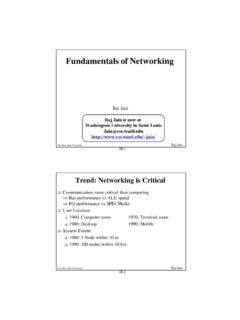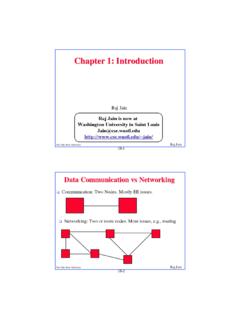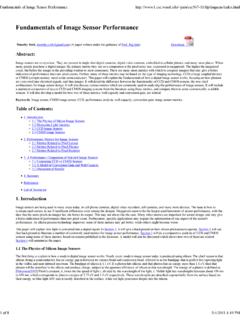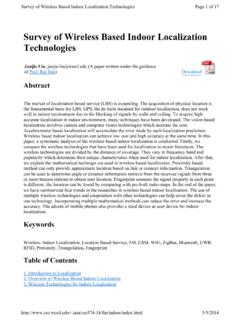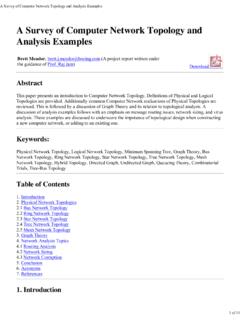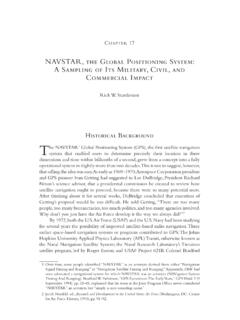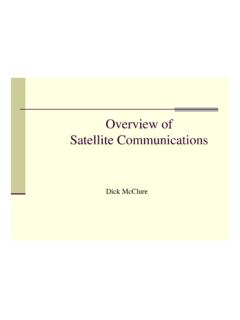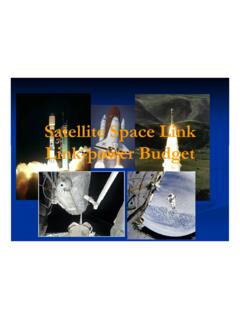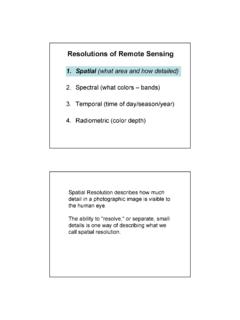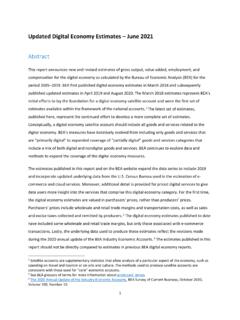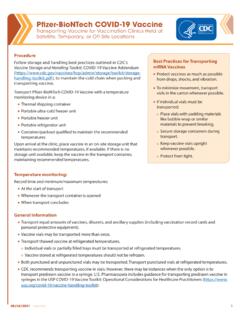Transcription of Satellite Communications
1 Satellite CommunicationsDavid Hart, paper is intended to give an overview of that methods of and uses for Satellite Communications , inaddition to presenting recent trends and future directions in the fieldOthet Reports on Recent Advances in NetworkingBack to Raj Jain's Home PageTable of ContentsIntroductionl Basic Elementsl Various Uses of Satellite CommunicationsTraditional Telecommunicationsm Cellularm Television SignalsC-Bandn Digitaln m Marine Communicationsm Spacebourne Land Mobilem Satellite Messaging for Commercial Jetsm Global Positioning Servicesm l Technological OverviewError CorrectionForward-error-correctionn Automatic-repeat-requestStop and Waitn Go-back-N tn Selective-repeatn n m Hybrid Networksm ATM over Satellitem SATINm VSAT Networksm Orbitsm l Satellite
2 ~jain/cis788-97/satellite_ (1 of 14) [2/7/2000 11:01:12 AM]GEOn LEOn ConstellationsGlobal Voice Communicationsn Global Broadband Networksn m ReferencesWeb Sitesm Books and Papersm l IntroductionIn 1962, the American telecommunications giant AT&T launched the world's first true communicationssatellite, called Telstar. Since then, countless Communications satellites have been placed into earth orbit, andthe technology being applied to them is forever growing in ElementsSatellite Communications are comprised of 2 main components:The SatelliteThe Satellite itself is also known as the space segment, and is composed of three separate units, namelythe fuel system , the Satellite and telemetry controls, and the transponder.
3 The transponder includes thereceiving antenna to pick-up signals from the ground station, a broad band receiver, an inputmultiplexer, and a frequency converter which is used to reroute the received signals through a highpowered amplifier for downlink. The primary role of a Satellite is to reflect electronic signals. In thecase of a telecom Satellite , the primary task is to receive signals from a ground station and send themdown to another ground station located a considerable distance away from the first. This relay actioncan be two-way, as in the case of a long distance phone call. Another use of the Satellite is when, as isthe case with television broadcasts, the ground station's uplink is then downlinked over a wide region,so that it may be received by many different customers possessing compatible equipment.
4 Still anotheruse for satellites is observation, wherein the Satellite is equipped with cameras or various sensors, andit merely downlinks any information it picks up from its The Ground is the earth segment. The ground station's job is two-fold. In the case of an uplink, or transmittingstation, terrestrial data in the form of baseband signals, is passed through a baseband processor, an upconverter, a high powered amplifier, and through a parabolic dish antenna up to an orbiting Satellite . Inthe case of a downlink, or receiving station, works in the reverse fashion as the uplink, ultimatelyconverting signals received through the parabolic antenna to base band Back to Table of ContentsSatellite ~jain/cis788-97/satellite_ (2 of 14) [2/7/2000 11:01:13 AM]Various Uses of Satellite CommunicationsTraditional TelecommunicationsSince the beginnings of the long distance telephone network, there has been a need to connect thetelecommunications networks of one country to another.
5 This has been accomplished in several cables have been used most frequently. However, there are many occasions where a largelong distance carrier will choose to establish a Satellite based link to connect to transoceanic points,geographically remote areas or poor countries that have little Communications infrastructure. Groupslike the international Satellite consortium Intelsat have fulfilled much of the world's need for this typeof CellularVarious schemes have been devised to allow satellites to increase the bandwidth available to groundbased cellular networks. Every cell in a cellular network divides up a fixed range of channels whichconsist of either frequencies, as in the case of FDMA systems, or time slots, as in the case of a particular cell can only operate within those channels allocated to it, overloading can occur.
6 Byusing satellites which operate at a frequency outside those of the cell, we can provide extra satellitechannels on demand to an overloaded cell. These extra channels can just as easily be, once free, usedby any other overloaded cell in the network, and are not bound by bandwidth restrictions like thoseused by the cell. In other words, a Satellite that provides service for a network of cells can allow itsown bandwidth to be used by any cell that needs it without being bound by terrestrial bandwidth andlocation Television SignalsSatellites have been used for since the 1960's to transmit broadcast television signals between thenetwork hubs of television companies and their network affiliates.
7 In some cases, an entire series ofprogramming is transmitted at once and recorded at the affiliate, with each segment then beingbroadcast at appropriate times to the local viewing populace. In the 1970's, it became possible forprivate individuals to download the same signal that the networks and cable companies weretransmitting, using c-band reception dishes. This free viewing of corporate content by individuals ledto scrambling and subsequent resale of the descrambling codes to individual customers, which startedthe direct-to-home industry. The direct-to-home industry has gathered even greater momentum sincethe introduction of digital direct broadcast ( - GHz) - Satellites operating in this band can be spaced as close as two degreesapart in space, and normally carry 24 transponders operating at 10 to 17 watts each.
8 Typicalreceive antennas are 6 to feet in diameter. More than 250 channels of video and 75 audioservices are available today from more than 20 C-Band satellites over North America. Virtuallyevery cable programming service is delivered via C-Band. SBCAm Ku-BandFixed Satellite Service (FSS)n m l Satellite ~jain/cis788-97/satellite_ (3 of 14) [2/7/2000 11:01:13 AM]Ku Band ( - GHz) - Satellites operating in this band can be spaced as closely astwo degrees apart in space, and carry from 12 to 24 transponders that operate at a widerange of powers from 20 to 120 watts each. Typical receive antennas are three to six feetin diameter. More than 20 FSS Ku-Band satellites are in operation over North Americatoday, including several "hybrid" satellites which carry both C-Band and Ku-Bandtransponders.
9 PrimeStar currently operates off Satcom K-2, an FSS or so-called"medium-power" Ku-Band Satellite . AlphaStar also uses an FSS-Ku Band Satellite ,Telestar 402-R. SBCAB roadcasting Satellite Service (BSS)Ku-Band ( - GHz) - Satellites operating in this band are spaced nine degreesapart in space, and normally carry 16 transponders that operate at powers in excess of 100watts. Typical receive antennas are 18 inches in diameter. The United States has beenallocated eight BSS orbital positions, of which three (101, 110 and 119 degrees) are theso-called prime "CONUS" slots from which a DBS provider can service the entire 48contiguous states with one Satellite . A total of 32 DBS "channels" are available at eachorbital position, which allows for delivery of some 250 video signals when digitalcompression technology is employed.
10 SBCAn DBSDBS (Direct Broadcast Satellite ) -The transmission of audio and video signals via Satellite directto the end user. More than four million households in the United States enjoy C-Band Ku-Band DBS surfaced in the late 1990s with high power Ku-Band DBSlaunched in 1994. SBCAm Marine CommunicationsIn the maritime community, Satellite communication systems such as Inmarsat provide goodcommunication links to ships at sea. These links use a VSAT type device to connect togeosynchronous satellites, which in turn link the ship to a land based point of presence to therespective nations telecommunications Spacebourne Land MobileAlong the same lines as the marine based service, there are VSAT devices which can be used toestablish communication links even from the world's most remote regions.


